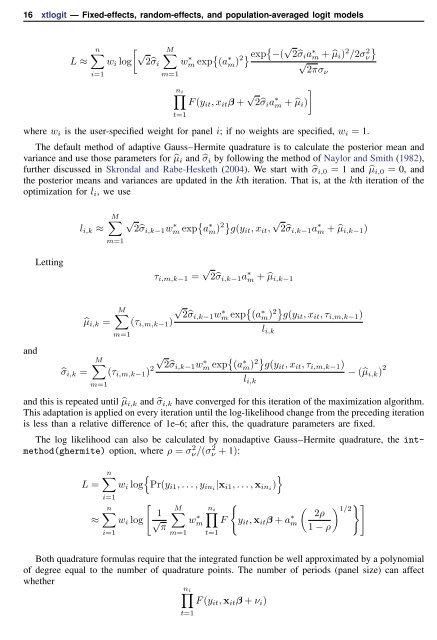xtlogit - Stata
xtlogit - Stata
xtlogit - Stata
Create successful ePaper yourself
Turn your PDF publications into a flip-book with our unique Google optimized e-Paper software.
16 <strong>xtlogit</strong> — Fixed-effects, random-effects, and population-averaged logit models<br />
L ≈<br />
n∑<br />
i=1<br />
[<br />
∑<br />
M<br />
w i log<br />
√2̂σi<br />
m=1<br />
∏n i<br />
t=1<br />
wm ∗ exp { (a ∗ m) 2}exp{ −( √ }<br />
2̂σ i a ∗ m + ̂µ i ) 2 /2σν<br />
2 √<br />
2πσν<br />
F (y it , x it β + √ ]<br />
2̂σ i a ∗ m + ̂µ i )<br />
where w i is the user-specified weight for panel i; if no weights are specified, w i = 1.<br />
The default method of adaptive Gauss–Hermite quadrature is to calculate the posterior mean and<br />
variance and use those parameters for ̂µ i and ̂σ i by following the method of Naylor and Smith (1982),<br />
further discussed in Skrondal and Rabe-Hesketh (2004). We start with ̂σ i,0 = 1 and ̂µ i,0 = 0, and<br />
the posterior means and variances are updated in the kth iteration. That is, at the kth iteration of the<br />
optimization for l i , we use<br />
Letting<br />
l i,k ≈<br />
M∑ √<br />
2̂σi,k−1 wm ∗ exp { a ∗ m) 2} g(y it , x it , √ 2̂σ i,k−1 a ∗ m + ̂µ i,k−1 )<br />
m=1<br />
τ i,m,k−1 = √ 2̂σ i,k−1 a ∗ m + ̂µ i,k−1<br />
and<br />
̂σ i,k =<br />
̂µ i,k =<br />
√ M∑<br />
2̂σi,k−1 wm ∗ exp { (a ∗<br />
(τ i,m,k−1 )<br />
m) 2} g(y it , x it , τ i,m,k−1 )<br />
m=1<br />
√ M∑<br />
(τ i,m,k−1 ) 2 2̂σi,k−1 wm ∗ exp { (a ∗ m) 2} g(y it , x it , τ i,m,k−1 )<br />
− (̂µ i,k ) 2<br />
l i,k<br />
m=1<br />
and this is repeated until ̂µ i,k and ̂σ i,k have converged for this iteration of the maximization algorithm.<br />
This adaptation is applied on every iteration until the log-likelihood change from the preceding iteration<br />
is less than a relative difference of 1e–6; after this, the quadrature parameters are fixed.<br />
The log likelihood can also be calculated by nonadaptive Gauss–Hermite quadrature, the intmethod(ghermite)<br />
option, where ρ = σ 2 ν/(σ 2 ν + 1):<br />
L =<br />
≈<br />
n∑<br />
i=1<br />
l i,k<br />
{<br />
}<br />
w i log Pr(y i1 , . . . , y ini |x i1 , . . . , x ini )<br />
[<br />
n∑ 1<br />
w i log √ π<br />
i=1<br />
∑<br />
M n i<br />
wm<br />
∗<br />
m=1 t=1<br />
{<br />
∏<br />
F y it , x it β + a ∗ m<br />
( ) }] 1/2 2ρ<br />
1 − ρ<br />
Both quadrature formulas require that the integrated function be well approximated by a polynomial<br />
of degree equal to the number of quadrature points. The number of periods (panel size) can affect<br />
whether<br />
∏n i<br />
F (y it , x it β + ν i )<br />
t=1
















